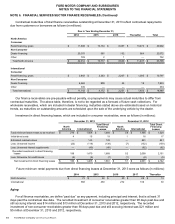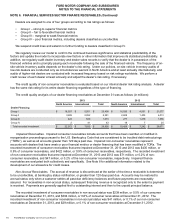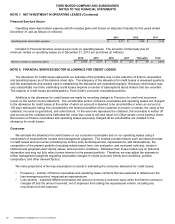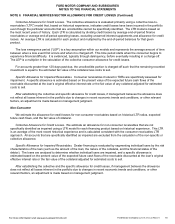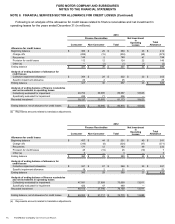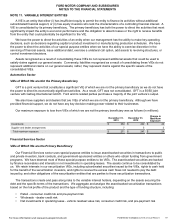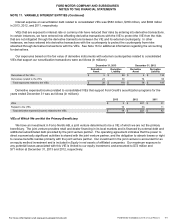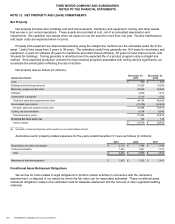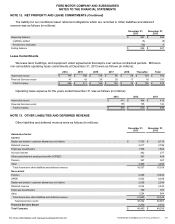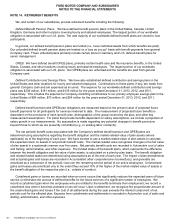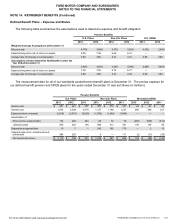Ford 2013 Annual Report Download - page 95
Download and view the complete annual report
Please find page 95 of the 2013 Ford annual report below. You can navigate through the pages in the report by either clicking on the pages listed below, or by using the keyword search tool below to find specific information within the annual report.Ford Motor Company | 2013 Annual Report 93
FORD MOTOR COMPANY AND SUBSIDIARIES
NOTES TO THE FINANCIAL STATEMENTS
NOTE 8. FINANCIAL SERVICES SECTOR ALLOWANCE FOR CREDIT LOSSES (Continued)
Collective Allowance for Credit Losses. The collective allowance is evaluated primarily using a collective loss-to-
receivables (“LTR”) model that, based on historical experience, indicates credit losses have been incurred in the portfolio
even though the particular accounts that are uncollectible cannot be specifically identified. The LTR model is based on
the most recent years of history. Each LTR is calculated by dividing credit losses by average end-of-period finance
receivables or average end-of-period operating leases, excluding unearned interest supplements and allowance for credit
losses. An average LTR is calculated for each product and multiplied by the end-of-period balances for that given
product.
The loss emergence period (“LEP”) is a key assumption within our models and represents the average amount of time
between when a loss event first occurs and when it is charged off. This time period starts when the consumer begins to
experience financial difficulty. It is evidenced, typically through delinquency, before eventually resulting in a charge-off.
The LEP is a multiplier in the calculation of the collective consumer allowance for credit losses.
For accounts greater than 120 days past due, the uncollectible portion is charged-off such that the remaining recorded
investment is equal to the estimated fair value of the collateral less costs to sell.
Specific Allowance for Impaired Receivables. Consumer receivables involved in TDRs are specifically assessed for
impairment. A specific allowance is estimated based on the present value of the expected future cash flows of the
receivable discounted at the loan’s original effective interest rate or the fair value of any collateral adjusted for estimated
costs to sell.
After establishing the collective and specific allowance for credit losses, if management believes the allowance does
not reflect all losses inherent in the portfolio due to changes in recent economic trends and conditions, or other relevant
factors, an adjustment is made based on management judgment.
Non-Consumer
We estimate the allowance for credit losses for non-consumer receivables based on historical LTR ratios, expected
future cash flows, and the fair value of collateral.
Collective Allowance for Credit Losses. We estimate an allowance for non-consumer receivables that are not
specifically identified as impaired using a LTR model for each financing product based on historical experience. This LTR
is an average of the most recent historical experience and is calculated consistent with the consumer receivables LTR
approach. All accounts that are specifically identified as impaired are excluded from the calculation of the non-specific or
collective allowance.
Specific Allowance for Impaired Receivables. Dealer financing is evaluated by segmenting individual loans by the risk
characteristics of the loan (such as the amount of the loan, the nature of the collateral, and the financial status of the
debtor). The loans are analyzed to determine whether individual loans are impaired, and a specific allowance is
estimated based on the present value of the expected future cash flows of the receivable discounted at the loan’s original
effective interest rate or the fair value of the collateral adjusted for estimated costs to sell.
After establishing the collective and the specific allowance for credit losses, if management believes the allowance
does not reflect all losses inherent in the portfolio due to changes in recent economic trends and conditions, or other
relevant factors, an adjustment is made based on management judgment.
For more information visit www.annualreport.ford.com







